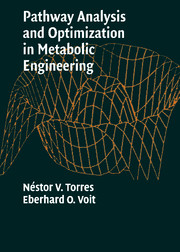Book contents
- Frontmatter
- Contents
- Preface
- 1 Target: A Useful Model
- 2 Methods of Biochemical Systems Theory
- 3 A Model of Citric Acid Production in the Mold Aspergillus niger
- 4 Optimization Methods
- 5 Optimization of Biochemical Systems
- 6 Optimization of Citric Acid Production in Aspergillus niger
- 7 Maximization of Ethanol Production in Saccharomyces cerevisiae
- 8 Conclusions
- Author Index
- Subject Index
- Plate section
- References
2 - Methods of Biochemical Systems Theory
Published online by Cambridge University Press: 28 July 2009
- Frontmatter
- Contents
- Preface
- 1 Target: A Useful Model
- 2 Methods of Biochemical Systems Theory
- 3 A Model of Citric Acid Production in the Mold Aspergillus niger
- 4 Optimization Methods
- 5 Optimization of Biochemical Systems
- 6 Optimization of Citric Acid Production in Aspergillus niger
- 7 Maximization of Ethanol Production in Saccharomyces cerevisiae
- 8 Conclusions
- Author Index
- Subject Index
- Plate section
- References
Summary
The appeal of the power-law approximation for representing enzyme-catalyzed reactions has led to the development of an entire modeling framework that is known in the field as Biochemical Systems Theory (BST). Hundreds of theoretical treatises and applications concerned with BST have been published in the peer-reviewed literature, in books, abstracts, and presentations. It is not the purpose of this chapter to provide a detailed and comprehensive treatment, and we will only highlight topics that are of relevance for the remainder of the book. The reader interested in further details, hands-on examples, and exercises is referred to a recent, comprehensive textbook on the subject (Voit 2000).
The typical modeling process contains the following components:
Model Design
Dynamic Analysis
Steady-State Analysis
Evaluation and Interpretation of Results
That looks pretty straightforward and simple. In reality, however, the process is not as direct as it may seem, but cyclic in nature. The first model design is seldom all encompassing and optimal. This usually becomes clear from the dynamic and steady-state analyses of the model or during the evaluation and interpretation of results. Indicators of potential problems arise in the form of discrepancies between model and observations, lack of robustness, or predictions that may not even be testable at the present time, but are suspect for one reason or another.
Diagnosis of these flaws may require further analyses that pinpoint the problems as precisely as possible and ultimately suggest a change in model design.
Information
- Type
- Chapter
- Information
- Publisher: Cambridge University PressPrint publication year: 2002
References
Accessibility standard: Unknown
Why this information is here
This section outlines the accessibility features of this content - including support for screen readers, full keyboard navigation and high-contrast display options. This may not be relevant for you.Accessibility Information
- 1
- Cited by
